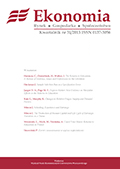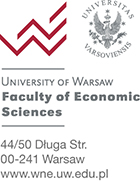A. Mach
ABSTRACT:
Full text (PDF)
Issue number: 30
In this issue:
Export Activity in Visegrad 4 Countries: Firm Level Investigation
A. Cieślik, J. Michałek, A. Michałek
ABSTRACT |
PDF
Following the new strand in the new trade theory literature that focuses on firm heterogeneity initiated by the Melitz [2003] model, in this paper we investigate the determinants of export activity of firms in the Visegrad-4 countries. The study covers the Czech Republic, Hungary, Poland and Slovakia and is based on firm level data for the 2002–2009 period.We will start with estimating probit regressions for the pooled dataset that includes all V-4 countries and will then disaggregate the sample into particular countries. Our preliminary estimation results obtained for the whole V-4 sample indicate that the probability of exporting increases with the higher share of university graduates in productive employment, larger spending on R&D projects, the use of foreign technology licenses, foreign ownership, higher productivity and company size. The results obtained for particular V-4 countries reveal some degree of heterogeneity among those countries.
Trade Diversity and Stages of Development—Evidence on EU Countries
A. Parteka
ABSTRACT |
PDF
The paper presents the dynamics of trade diversification with respect to stages of development in the European context. The analysis focuses on EU27 countries observed across the years 1988–2010 and compared to a sample of 136 international economies at all levels of income per capita. We will use product level statistics (six digit HS0) and confront export and import patterns of absolute diversification/concentration. The results show that in line with \‘stages of diversification\’ approach [Imbs and Wacziarg, 2003], EU27 countries are characterized by a high degree of trade diversity (on average, EU27 countries export 78% and import 90% of goods effectively exported and imported at the world level) and within the analyzed period most of them registered a reconcentration of trade structures. Obtained estimation results confirm a positive relationship between trade diversity and economic development levels (conditional mainly upon the size of the country) with a possibility of reconcentration at higher stages of development (observable in nonparametric estimates).
Does Monetary Integration Have an Effect EU’s Trade Change During Economic Crises?
K. Śledziewska, B. Witkowski
ABSTRACT |
PDF
This paper contributes to the discussion about economic effects of monetary integration and the problem of model stability during economic crisis. The fundamental goal of this research is twofold: firstly, to investigate the effect of different stages of economic integration on export to EU and non-EU countries, from becoming a member of the European Union (EU) to the Eurozone (EZ). Secondly, to check whether the functional form of the model can be considered stable over time as in the meantime the world entered the crisis phase. For an empirical test a data set covering the period from 1994 to 2010 has been used. The standard factors of gravity models, such as the size of the markets of trade partners, GDP per capita of trade partners etc. have been tested in the log-linear specification of the gravity model. In order to control the effect of monetary integration, several dummy variables indicating the process of monetary integration were added. Positive effects of growing GDP and GDP per capita, as usual, are expected. What is also assumed is that participation in amonetary union does not enhance exports to the EU and Eurozone countries. To test for this hypothesis, and to exercise control over additional factors, a model based on panel data with the use of Hausman-Taylor method was estimated. Surprisingly, it was found out that even though the impact of joining the EU and ERM on export has been positive, joining the Eurozone has given the opposite result. It will also be demonstrated that some of the parameters could be considered stable in the long run, but this is not relevant to all of them. Keywords: international trade, monetary integration, gravity model.
Does Students’ International Mobility Increase Their Employability?
T. Gajderowicz, G. Grotkowska, L. Wincenciak
ABSTRACT |
PDF
During the last 20 years international mobility of Polish students grew significantly. The article addresses the issue of consequences of international mobility for graduates\’ employability. Theoretical literature suggests several channels through which internationalmobilitymay affect graduates\’ attractiveness in the labour market: by accumulation of additional human capital, by signalling high abilities of a job candidate, by increasing search intensity of jobseekers. In fact, simple comparison of employment rates and duration of a post-graduation job search suggest that mobility experience increases employability of higher education graduates. However the results of Cox proportional hazard model with a control for other graduates\’ characteristics reveals a different picture: mobility per se does not impact job search duration but is correlated with graduates\’ characteristics associated with higher abilities. It seems, therefore, that international mobility experience may serve as a screening device and be used by firms for the purpose of recruiting better candidates.
Corruption and the Level of Trade Protectionism
M. Ghodsi
ABSTRACT |
PDF
In this paper, impacts of corruption on the level of trade protectionism, trade openness, and imports are analyzed. It is argued that special interest groups who are lobbying with corrupted governments might seek more benefits in some special subgroups of imports. Possible country and time specific fixed effects, endogeneity and some other problems in the regressions are controlled to achieve results that are more robust. Corruption measures from two different sources of Worldwide Governance Indicator and Transparency International website are analyzed in two separate similar approaches. It is finally concluded that both measures of corruption implicate negative influence on only one import subgroup, while there is no significant impact on protectionism measures.
Estimation of Tariffs Equivalents in Transportation Services Sector
A. Mach
ABSTRACT |
PDF
In this study I am focusing on the definition of tariff equivalents in the services sector. The contemporary solutions to the problem of quantifying the qualitative attributes of services trade are often limited to a single country or are difficult to reproduce. Basing my work on the solution introduced by Park [2002] Iwill present an empirical study aiming at quantifying the restrictions to international trade of services in a way that enables comparison of outcomes between countries and observation of changes in the restrictiveness level over time. The analysis assumes that restrictiveness level is responsible for the distortions of the empirical trade flows from theoretical expectations. The outcome is a time series of indices describing the restrictiveness level which can be used in further studies using panel data analysis. In this study I will present the indices obtained for the transport services sector.

